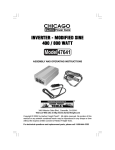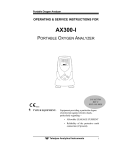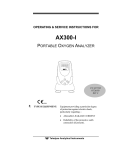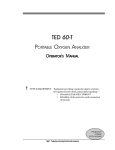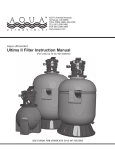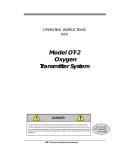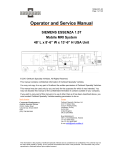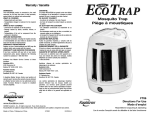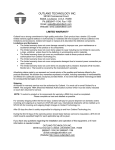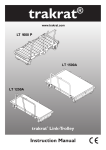Download Teledyne TED 191 User's Manual
Transcript
TED ' PORTABLE OXYGEN MONITOR INSTRUCTION MANUAL TYPE B EQUIPMENT: Equipment providing a particular degree of protection against electric shock, particularly regarding— • allowable LEAKAGE CURRENT • Reliability of the protective earth connection (if present). P/N TM0021 04/03/00 ECO # 00-0086 TELEDYNE ELECTRONIC TECHNOLOGIES Analytical Instruments i COPYRIGHT © 1996 TELEDYNE ELECTRONIC TECHNOLOGIES – ANALYTICAL INSTRUMENTS All Rights Reserved No part of this manual may be reproduced, transmitted, transcribed, stored in a retrieval system, or translated into any other language or computer language in whole or in part, in any form or by any means, whether it be electronic, mechanical, manual, or otherwise, without the prior written consent of Teledyne Electronic Technologies Analytical Instruments, 16830 Chestnut Street, City of Industry, CA 91749-1580 Phone (626) 934-1500 FAX (626) 961-2538 Technical Support: (626) 934-1673 TWX (910) 584-1887 TDYANLY COID or your local representative. WARRANTY STATEMENT The electronic control and display components of the TED 191 Portable Oxygen Monitor are warranted against defective workmanship and materials for 24 months from date of shipment from Teledyne. The class T-7 Micro-Fuel Cell is warranted for one year from the date of shipment from Teledyne. The liability of Teledyne, if any, shall be limited solely to the replacement and repair of the goods, and shall not include shipping costs or other incidental damages as defined in Section 2-715 of the U.S Uniform Commercial Code. This warranty is null and void if any goods are subjected to misuse, negligence, accident or repairs other than those performed by Teledyne or an authorized service center. Caution: Federal Law restricts this device to sale by or on the order of a physician. TELEDYNE ELECTRONIC TECHNOLOGIES Analytical Instruments 2 TABLE OF CONTENTS SECTION TOPIC PAGE NUMBER INTRODUCTION 4 APPLICATIONS 5 DESCRIPTIONS OF FUNCTIONAL ZONES: FRONT PANEL REAR PANEL 6 7 OPERATIONS: 1. 1.1 1.2 1.3 1.4 1.5 1.6 SET-UP INSTALL THE BATTERIES INSTALL THE SENSOR CALIBRATE THE INSTRUMENT NORMAL OPERATION SET THE ALARMS 8 9 10 11 12 13 2. ANAESTHETIC AGENTS 14 3. CLEANING 15 4. DO’S AND DON’T’S 16 5. ROUTINE MAINTENANCE 6. TROUBLESHOOTING 18 7. TECHNICAL SPECIFICATIONS 20 8. EFFECT OF PRESSURE 22 9. EFFECT OF HUMIDITY 23 10. EFFECT OF TEMPERATURE 24 11. DISCREPANCY IN READING 25 12. REPAIR SERVICE 26 SENSOR CELL REPLACEMENT LOG 27 TECHNICAL SERVICE LOG 28 GENERAL NOTES 29 SPARE PARTS LIST 30 . 17 TELEDYNE ELECTRONIC TECHNOLOGIES Analytical Instruments 3 INTRODUCTION The TED 191 Portable Oxygen Monitor is an easy-to-use, portable instrument that provides fast and accurate oxygen monitoring and audio-visual alarm capability. The TED 191 is designed to monitor concentrations of up to 100% oxygen in medical gas mixtures. The TED 191 Portable Oxygen Monitor is designed and manufactured in accordance with strict performance and quality protocols and subject to ISO 9002 Quality System protocols. When used correctly, this instrument will provide you with many years of trouble free service. The TED 191 Portable Oxygen Monitor is a compact, self-contained unit, which is battery powered by four (4) dry cell batteries (size AA/penlight). TELEDYNE ELECTRONIC TECHNOLOGIES Analytical Instruments 4 APPLICATIONS The instrument is designed for the measurement of oxygen concentrations in a variety of medical gas mixtures. It is recommended that the instrument be used only as a secondary measuring device to verify the concentration of oxygen in gas mixtures prepared using a gas blender or similar apparatus. The use of this monitor as a primary or only means of preparing gas mixtures is not advised. The monitor is capable of verifying oxygen concentrations in gas mixtures used in: • • • • Anesthesia Neonatal Intensive care Adult Intensive care Respiratory / Oxygen Therapy TELEDYNE ELECTRONIC TECHNOLOGIES Analytical Instruments 5 DESCRIPTION OF FUNCTIONAL ZONES FRONT PANEL High Alarm Setting Knob 50 Alarm Mute Button Calibration Control 60 TELEDYNE 70 40 30 80 HI 90 21 50 X 102 60 70 40 30 80 LO % OXYGEN OXYGEN MONITOR 90 21 21 I O 102 Liquid Crystal Display (LCD) Low Alarm Setting Knob On / Off Switch On / Off Switch Allows the operator to turn the instrument on and off. Alarm Mute Switch Allows the operator to “mute” the sound of the audible alarm signal for ± 60 seconds. During this time, a red signal lamp will flash, indicating a “muted” alarm condition is in force. Calibration Control Allows the operator to calibrate the instrument to one primary set point (usually 100%) in accordance with the designated calibration protocol. This protocol is defined further in this manual and also. Instructions in abbreviated form can be found on the top of the monitor casing. High Alarm Setting Allows the operator to define a high alarm threshold limit. Range 18% to 102% - if the actual measured value as displayed on the LCD exceeds this set threshold, an audible and visual alarm condition will be invoked. Low alarm setting Knob Allows the operator to define a low alarm threshold limit. Range 18% to 100% - if the actual measured value as displayed on the LCD falls below this set threshold, an audible and visual alarm condition will be invoked. Liquid Crystal Display Displays measured oxygen concentration, low battery condition and provides a visual indication of either a high (+) or low (-) alarm threshold violation. TELEDYNE ELECTRONIC TECHNOLOGIES Analytical Instruments 6 DESCRIPTION OF FUNCTIONAL ZONES REAR PANEL Sensor Cable Connector Plug Battery Drawer Battery Drawer The Battery Drawer contains 4 x AA (Penlight) batteries required to power the instrument. Sensor Cable Connector Plug The Oxygen Sensor Connector Cable is plugged into this “one way” socket. TELEDYNE ELECTRONIC TECHNOLOGIES Analytical Instruments 7 SECTION ONE OPERATIONS Note : Upon receipt, inspect the entire unit and accompanying accessories for damage or broken or loose parts. If damaged, do not use. Notify the Shipper, and consult Teledyne Electronic Technologies Analytical Instruments 1.1 SET-UP To set-up your TED 191 Portable Oxygen Monitor : 1.1.1 Install the Batteries See 1.2 below for procedure 1.1.2 Install the Sensor See 1.3 below for procedure 1.1.3 Calibrate the Instrument See 1.4 below for procedure 1.1.4 Normal Operation See 1.5 below for procedure 1.1.5 Set the Alarms See 1.6 below for procedure TELEDYNE ELECTRONIC TECHNOLOGIES Analytical Instruments 8 OPERATIONS 1.2 INSTALLING THE BATTERIES Withdraw the battery drawer from the monitor casing, by grasping the side lugs located on either side of the battery drawer, and, firmly pinching them inwards, simultaneously pull the drawer outwards. When new, this action can be somewhat stiff and difficult to execute. Care should be taken not to damage either the drawer or the casing of the monitor when executing this procedure. Fresh batteries must be inserted into the four battery recepticles located within the battery drawer assembly. Care should be taken to ensure that the correct battery polarity is maintained. Caution : Improper installation of the batteries may result in heat damage to the batteries. Re-insert the battery drawer into the monitor casing, and close. TELEDYNE ELECTRONIC TECHNOLOGIES Analytical Instruments 9 OPERATIONS 1.3 INSTALLING THE OXYGEN SENSOR The T-7 Oxygen Sensor must be installed before the instrument can be used. Ensure that the monitor is switched off. Remove the sensor from its protective bag. Inspect the sensor for damage or electrolyte leakage. If the sensor is damaged obtain a replacement. Do not use the defective sensor as it may be damaged. Caution: the sensor electrolyte is caustic. Do not let it come into contact with skin. If it does, immediately flush the affective area with water. Consult the Emergency First Aid procedures as set out in the Material Safety Data Sheet for the sensor. Do not attempt to open or repair the sensor. Leaking or exhausted sensors should be disposed of in accordance with local regulations. Consult the Material safety Data Sheet supplied with the sensor. Plug one end of the coiled cable into the telephone jack receptacle on the end of the sensor. The jack will only fit one way, so if it does not fit, rotate it until it slides in easily. Plug the other end of the coiled cable into the receptacle located on the right hand side of the rear panel of the instrument. This jack will only fit one way, so do not force it. Note : For sterilization procedures on the Oxygen Cell, see Section 3 on Page 15 below. Caution : Do NOT autoclave the oxygen sensor TELEDYNE ELECTRONIC TECHNOLOGIES Analytical Instruments 10 OPERATIONS 1.4 CALIBRATE THE INSTRUMENT Calibration should be effected at least once per shift, and always prior to the use of the instrument. Note: Never expose the sensor to varying temperatures while calibrating (i.e never hold the sensor in your hand) Ensure that the instrument is switched on, and that the oxygen sensor is connected to the instrument via the coiled cable. Expose the sensor tip to pure (100%) free flowing oxygen (a flow rate of approximately 6 to 8 litres per minute is recommended). Tip: For best calibration results, use a T-adapter and flow diverter within a flow circuit, with the flow diverter attached to the sensor, allowing pure dry oxygen to flow past the sensor assembly. Allow the displayed value to stabilize. Pull out the Calibration Control Knob and rotate until the displayed value is stable at 100%. At this point, push the Calibration Control Knob back into its locked position. Turn off oxygen supply and place sensor in ambient air. Remove the flow diverter from the Sensor, if one was used during the calibration process, Observe that the displayed value falls to 21% (±2%). Calibration has been successful. In the event that the displayed value does not reflect 21% (±2%), initiate a re-calibration (following the steps outlined above). In the event that calibration is once more unsuccessful, check that the purity of the calibration gas being used is valid. If the quality of the oxygen being used in the calibration process is acceptable, and calibration is still impossible, replace the oxygen sensing cell. Note: The calibration process should always be executed in dry, non-humidified oxygen. Water vapour dilutes the oxygen concentration which can produce errors in the calibration. The accuracy of the instrument is only as good as the quality of the calibration process. Note: It is not uncommon for the ambient air in hospital wards to be as high as 23%. If the unit fails the 21% calibration reading move the instrument to a location where oxygen contamination is unlikely. TELEDYNE ELECTRONIC TECHNOLOGIES Analytical Instruments 11 OPERATIONS 1.5 NORMAL OPERATION Switch the instrument on using the On–Off Switch. Validate the calibration of the instrument by exposing the oxygen sensor to room air, and verifying that the display on the instrument reads 100% (± 2 %). A further check can be carried out by exposing the sensor to a stream of 21% oxygen, and verifying that the display on the instrument reads 100% (± 2 %). Should this validation procedure indicate that the instrument is out of calibration, follow the calibration procedures set out in 1.4 above. Once the calibration of the instrument has been verified, place the sensor tip within the stream of gas (e.g. breathing circuits) or the localised environment (e.g. incubators or oxygen tents) that requires to be monitored. It is highly recommended that a flow diverter be used when monitoring a dynamic gas stream. This will prevent sample stagnation, and create a vortex effect that will facilitate a more accurate continuous assessment of the gas stream being monitored. The flow diverter should be plugged into a T-adapter, which must be located in line. Note: Check the breathing circuit for leaks. Ensure that the circuit downstream of the sensor does not produce any back-pressure or restrictions of the gas flow, or errors in the readings will result. When using the instrument in a static environment, such as in an incubator, the flow diverter should be removed so that it does not interfere with the rapid exchange of gases through the gas permeable membrane of the sensor cell. When it is necessary to thread the cable through a small hole in order to gain access to the inside of the chamber, the instrument should be switched off, the cable should be disconnected at the sensor, threaded through the hole, and reconnected inside the chamber (see1.3 above), before commencing as described above. Note: Failure to remove the flow diverter will result in the marked slowing of the sensor response time. The instrument will display the measured oxygen concentration. The high and low alarms should be set as detailed in 1.6 below. When using the instrument in the presence of anaesthetic agents, it is possible for the measured value to reflect a fall. The magnitude of this fall is related to the level of oxygen concentration and the duration of the exposure to the anaesthetic agent. See 1.7 below for further details. TELEDYNE ELECTRONIC TECHNOLOGIES Analytical Instruments 12 OPERATIONS SET THE ALARMS The lines indicating the 100% graduations around the High and Low Alarm Settings Knobs are only intended as guides, and not as precise settings. Once the desired oxygen concentration has been set, bring the high alarm setting down, by turning the High Alarm Setting Knob anti-clockwise, until the alarm is triggered, and then take the high alarm setting up by approximately 5%. Bring the low alarm setting up, by turning the Low Alarm Setting Knob clockwise, until the alarm is triggered, then take the setting down by approximately 5%. These settings will create a “window” of approximately 10%, within which the set oxygen concentration will now be measured. This window can be increased or decreased, according to the users requirements. Any deviation from this set window will trigger the alarm. The graph alarm is accurate at 100% and within ±8% at 21%, and the low alarm is most accurate at 21%, and within ±8% at 100%. This is depicted in the graph below. Oxygen Monitor Alarm Setting Tolerances 100 80 Alarm Setting 1.6 Alarm Point 60 Low Alarm High Alarm 40 20 20 40 60 80 100 Oxygen Concentration Reading The instrument will alarm at any oxygen concentration below 18%. In the event of a violation of the pre-set alarm limits, the instrument will provide both an audible and a visual alarm signal. Under these conditions, it is possible to “mute” or temporarily silence the audible alarm tone for about 60 seconds to allow corrective action to be taken. If the condition is not rectified within this time, then the audible alarm tone will be automatically reinstated. Audible alarm signals are tonally matched to the type of threshold violations i.e. low alarm violations are signalled via a lower pitched audible signal, while high alarm violations are signalled via a higher pitched audible signal. TELEDYNE ELECTRONIC TECHNOLOGIES Analytical Instruments 13 SECTION TWO 2. ANAESTHETIC AGENTS ANAESTHETIC AGENTS The anaesthetic agents listed in the following table (Halothane, Enflurane, Isoflurane Sevoflurane, and Desflurane) were vaporised into a stream of 30%oxygen / 70% nitrous oxide. The resultant drops in displayed oxygen concentration after a 2 hour exposure period were observed. Exposurers in excess of 2 hours will provide marginally greater errors. The errors listed are typical for all gas permeable membrane oxygen sensors. Exposure of the sensor to gas, free from any anaesthetic contamination, for a period of equal or greater than the exposure period, will eliminate the measurement error in most instances. Gas or Vapor Level (Balance : Mixture of 30% O2 / 70% N2O, except where noted) Gas or Vapor Helium Nitrous Oxide Carbon Dioxide Halothane Enflurane Isoflurane Sevoflurane Desflurane Test Level 50%, balance O2 80%, balance O2 10%, balance O2 4% 5% 5% 5% 15% Oxygen Reading Error 0% 0% 0% * < -1.5% O2 * < -1.5% O2 * < -1.5% O2 * < -1.5% O2 * < -1.5% O2 * Errors are approximate and may vary based on exposure times and concentrations. These performances meet or exceed the requirements of ISO 7767: 1997 (E) Caution: The TED 191 Portable Oxygen Monitor should not be used in the presence of flammable anaesthetics such as diethal ether or cyclpropane. The T-7 oxygen sensor should not be left in nitrous oxide mixtures any longer than absolutely necessary. After exposure to nitrous oxide mixtures, the sensor should be left in 100% oxygen overnight (e.g. left in a breathing circuit that has been flushed with pure oxygen). If the oxygen reading continues to drop after each use in nitrous oxide, the sensor should be removed from service. If the sensor can no longer be calibrated, or if there is any sign of electrolyte leakage, the sensor should be disposed of in accordance with local regulations and the specific guidelines as given in the Material Safety Data Sheet of the sensor. TELEDYNE ELECTRONIC TECHNOLOGIES Analytical Instruments 14 SECTION THREE CLEANING AND STERILISATION 3.1 CLEANING THE TED 191 PORTABLE OXYGEN MONITOR The instrument itself should be cleaned using a damp cloth. In the event of an excessive build-up of dirt, a mild alcohol solution (isopropyl) may be used to wipe over the instrument, which should be allowed to air-dry afterwards. In extreme cases, the monitor casing may be cleaned using a mild detergent. Note: 3.2 The Accurox Oxygen monitor cannot be liquid sterilised or autoclaved – irreparable damage may result. STERILISING THE T-7 OXYGEN SENSOR AND CONNECTING CABLE The T-7 oxygen sensors and connecting cables used on the instrument may be gas sterilised using low temperature ethylene oxide. A vacuum must not be drawn on the sensor during the sterilisation process. TELEDYNE ELECTRONIC TECHNOLOGIES Analytical Instruments 15 SECTION FOUR DO’S AND DON’TS DO’S ; Read the Operators Manual thoroughly before using the instrument. ; Calibrate once per shift, and prior to each and every use. ; Check the high and low alarm threshold settings prior to use. ; Replace the batteries immediately when required. ; Keep the instrument, cable and sensor dry at all times. ; Re-calibrate after changing the sensor or batteries. ; Visually inspect the whole instrument prior to use. ; Check the integrity of all cable connections routinely. ; Remove and carefully store the “flow diverter” when using the instrument in “static” environments such as incubators, oxygen hoods etc. ; Perform an alarm functionality test prior to each use. ; Remove batteries if the instrument is not to be used for a month plus DON’TS : Use the Accurox Oxygen Monitor if you suspect any malfunction. : Use the monitor in the presence of flammable anaesthetics. : Autoclave the instrument and/or the sensor. : Submerge the instrument and/or sensor in water or any other liquid. : Expose instrument to other equipment with high levels of RFI emission. : Place the instrument itself in a water vapour saturated environment. : Expose the LCD to excessive direct sunlight : Dispose of the sensor cell in fire, or place in an incinerator. TELEDYNE ELECTRONIC TECHNOLOGIES Analytical Instruments 16 SECTION FIVE ROUTINE MAINTENANCE 5.1 ROUTINE VISUAL INSPECTION Always inspect the instrument prior to use for obvious damage or for parts or components missing. Make a point of checking the oxygen sensor cell for signs of electrolyte leakage, water condensation on the sensing surface. Also check the integrity of the cable and all cable connections. 5.2 CHANGING BATTERIES From time to time the 4 x AA (penlight) dry cell batteries that power the instrument will require replacement. This requirement will be indicated via a "LO BAT" alarm message located in the top left hand corner of the LCD display. It is also possible, if the instrument has not been used for sometime, that the batteries will be depleted to the extent that the instrument will not power up when switched on. In both instances, the batteries must be replaced. To change the batteries, follow the procedures set out in 1.2 above. Initiate a calibration once the new batteries are installed prior to using the instrument. 5.3 CHANGING THE OXYGEN SENSOR CELL From time-to-time the oxygen sensor cell, being a consumptive electro-chemical device, will require replacement. This requirement will be indicated via an inability to achieve calibration i.e the range provided by the Calibration Control Knob will not be sufficient to achieve the setting of 100% on the LCD display when exposing the sensor tip to 100% pure oxygen. To change the oxygen sensor, follow the procedures set out in 1.3 above. Initiate a calibration once the new sensor has been installed prior to using the instrument. A Sensor Cell Replacement Log has been provided for the reference of the users, and is located at the back of this Instruction Manual. The details of the replacement sensor should be entered into this log at the time of changing. TELEDYNE ELECTRONIC TECHNOLOGIES Analytical Instruments 17 SECTION SIX TROUBLESHOOTING SYMPTOM CURE / REMARK 1) Check battery drawer is properly located. No numeric display on the LCD when powered on 2) Check battery polarity . 3) Check batteries for replacement 4) External power : check polarity and voltage of supply; : check if functional on batteries. 1) Check calibration process (as described in section 1.4). 2) Check flow rate of calibrating gas (6 – 8 lpm) 3) Check sensor cell connection. 4) Check sensor cable connection. Inability to achieve calibration 5) Check quality of calibration gas. 6) Check that the calibration gas is dry (not humidified). 7) Wait for 1 or 2 minutes, then attempt a re-calibration. 8) Check sensor cell for damage or electrolyte leaks. 9) Return monitor to authorized service agent for repair. Constant non-mutable alarm condition Drift is displayed readings whilst calibrating or immediately thereafter 1) Check high and low alarm settings for possible “crossed” settings i.e. high threshold value is set lower than low threshold value. 1) Do not hold the sensor whilst calibrating, as the warmth from your hand may cause the ambient temperature compensation circuit to activate, resulting in unstable displayed values. 2) Try calibrating a known “good” sensor. 3) Repeat calibration. 4) Replace the sensor cell. There is no reaction to changes in oxygen concentration 1) Remove the sensor tip from the T-adaptor, unscrew the “flow diverter” and gently swab any excess moisture off the sensor cell membrane, then flow dry gas over the membrane. TELEDYNE ELECTRONIC TECHNOLOGIES Analytical Instruments 18 TROUBLESHOOTING SYMPTOM CURE / REMARK 1) Remove the sensor tip from the T-adaptor, unscrew the “flow diverter” and gently swab any excess moisture off the sensor cell membrane, then flow dry gas over the membrane. The displayed readings are unstable 2) Check for a source of RFI emission. Relocate the instrument. 3) Check that the calibration control knob is properly locked in position. 1) The sensor is not plugged in. Instrument reads “00” 2) There is bad sensor/cable or cable/monitor connection. Displayed value drifts by 2 – 3% over 3 – 4 hours Alarm continuously activates when displayed value is less than 18% 1) Replace sensor cable. 2) Replace cable. 1) The minimum low alarm threshold is 18%. The Teledyne TED 191 will always alarm under these conditions. TELEDYNE ELECTRONIC TECHNOLOGIES Analytical Instruments 19 SECTION SEVEN TECHNICAL SPECIFICATIONS Complies to IEC 601 – Safety of Medical Equipment Internally powered equipment SAFETY CLASSIFICATION Drip proof – IPX 1 Not suitable for used with flammable anaesthetic mixture POWER Internal : DC 6V, 4 dry cell batteries – size AA/penlight MASS 525 grams (with T-7 oxygen sensor) DIMENSIONS 59mm (H) x 152mm (W) x 115mm (D) Approximately 900 hours of continuous non-alarming operation BATTERY DURATION Low battery status indication is provided Replace batteries within 48 hours of low battery indication High oxygen concentration (18% to 102%) Low oxygen concentration (18% to 100%) ALARMS Low battery (visual alarm only) Most alarm conditions are signalled audibly and visually, with a 60 second audible alarm mute facility provided MEASUREMENT RANGE 0 to 100% of localised environmental oxygen concentration DISPLAY TYPE Liquid Crystal Display (LCD) SENSOR TYPE Class T-7 (Galvanic) ACCURACY Approximately 2% linear SENSOR LIFE Approximately 12 months in most applications TELEDYNE ELECTRONIC TECHNOLOGIES Analytical Instruments 20 TECHNICAL SPECIFICATIONS SENSOR RESPONSE TIME Less than 6 seconds to 90% of final measured value in response to a step change in the actual oxygen concentration being measured. Technical manual will be supplied on request to user’s appropriately qualified personnel for repair of components designated as repairable by the manufacturer. SERVICE No parts (other than the sensor cell, and dry cell batteries) deteriorate during normal use. Can be stored and transported between -30°C and +50°C STORAGE AND TRANSPORT Can be stored and transported at up to 75% relative humidity (noncondensing) Operation of instrument is unaffected by : Humidity (water vapour saturated gas); GENERAL Pressure (up to 100cm H2O); Nitrous oxide (N2O), Halothane, Enflurane or any other anaesthetic gas or vaporised agent. Multiple mounting bracket configurations to suit any mounting requirement. (Custom engineered solutions available on request). TELEDYNE ELECTRONIC TECHNOLOGIES Analytical Instruments 21 SECTION EIGHT EFFECT OF PRESSURE Virtually all gas sensors and analysers measure the partial pressure, not the percentage, of the gas that they sense. The only time that these instruments can accurately read percentages is when the total pressure does not vary over time between calibration and use. This is why it is important to calibrate the TED 191 Portable Oxygen Monitor at regular intervals. It is recommended that the instrument be calibrated prior to each use or every 8 hours. When the sensor is connected to a ventilator circuit, the alternating "breathing" pressure cycles generated by the ventilator will be sensed as an increase in the oxygen percentage (especially if the sensor is fast enough to sense the changes). In reality, the percentage of oxygen is not changing; it is the total pressure that is increasing, producing a corresponding increase in the partial pressure of oxygen. A hundred-centimeter water pressure pulse will produce a .11 atmosphere, or an 11% increase in the total and therefore partial pressure of oxygen. Assuming that the sensor is fast enough to track this pressure pulse, an unpressurised reading of 50% oxygen will increase to 55.3% if the sensor is subjected to a pressure cycle of 100cm H2O. The reading will rise proportionally less for smaller pressures. TELEDYNE ELECTRONIC TECHNOLOGIES Analytical Instruments 22 SECTION NINE HUMIDITY EFFECT OF Humidity does not directly affect the accuracy of the sensor's measurement. However, when a nebuliser or other device is used to increase moisture levels in gas mixtures, the moisture actually dilutes the mixture. This dilution effect decreases the oxygen concentration. For example, if an 80% oxygen gas mixture is humidified to saturation at room temperature, the resulting gas mixture will contain only 77.5% oxygen. Your TED 191 Portable Oxygen Monitor accurately measures decreases in the oxygen concentration due to the dilution effects of moisture added to gas mixtures. As with all oxygen sensors, excessive condensation on the sensing surface will block the diffusion of oxygen to the sensor, rendering it inoperative. It is recommended that the sensor be installed on the dry side of the breathing circuit at all times. Water condensate on the exposed cable contacts at the rear of the sensor may affect the oxygen reading and should be removed by shaking out the condensed water and allowing the sensor to air dry. TELEDYNE ELECTRONIC TECHNOLOGIES Analytical Instruments 23 SECTION TEN TEMPERATURE EFFECT OF The Teledyne Electronic Technologies Analytical Intruments sensors adjust for ambient temperature changes in the range of 0 - 40ºC (32 - 106ºF). Since the thermistor that compensates for these changes is located in the rear of the sensor assembly, it is important that gas mixtures, flowing over the front of the sensor, be at room temperature. Reading errors may occur if hot gases from a heated humidifier are directed past a sensor teed into a breathing circuit. A small thermal tracking error may be encountered in applications where the entire sensor assembly is placed in the gas mixture to be analysed (e.g incubators). No adjustments should be made during this period (about 1 to 2 hours), since this error will be eliminated when both the thermistor and sensing electrode have had sufficient time to come to thermal equilibrium. TELEDYNE ELECTRONIC TECHNOLOGIES Analytical Instruments 24 SECTION ELEVEN READINGS DISCREPANCY IN The TED 191 is intended to be used as a secondary oxygen monitor, meaning that it is intended to verify the accuracy of and check the oxygen concentration leaving another oxygen mixing device or primary life support system (i.e a blender or anaesthesia machine). Whenever there is a significant difference in the oxygen readings between the primary and secondary monitors, the discrepancy must be resolved immediately. The information obtained from the TED 191 should never be used to make adjustments to the primary life-support system, but should only be used as an indication that the primary device may require service and/or calibration. The "LO BAT" message immediately tells you if the batteries need replacing. The TED 191 should momentarily be removed from the application area and the batteries replaced. If the TED 191 can be calibrated, the unit can be assumed to be in good working order and capable of providing readings to specification. If after re-installing the TED 191, the discrepancy in oxygen readings persists, the problem is most likely elsewhere (i.e flow blockage, primary device error, etc.). Further investigation should be made until the discrepancy in readings is resolved. If it is found that replacing the sensor and/or batteries does not give proper calibration results, the troubleshooting section of this manual should be consulted. TELEDYNE ELECTRONIC TECHNOLOGIES Analytical Instruments 25 SECTION TWELVE SERVICE REPAIR In the event that your TED 191 Portable Oxygen Monitor requires service, the following steps will help to ensure that the repair request is processed promptly : Contact your authorised Teledyne Electronic Technologies Analytical Instruments distributor or factory for return instructions. Do not ship your monitor without first obtaining authorisation. Include a copy of the sales invoice or other proof of purchase date. Warranty service may be denied if no proof of purchase is included. It is your responsibility to pay shipping charges to Teledyne Analytical Instruments. If the unit is under warranty, the serviced or replaced monitor will be returned to you postage prepaid. Monitors and sensors damaged by accident or misuse are not covered by the warranty. In these cases, service charges will be based on time and materials. TELEDYNE ELECTRONIC TECHNOLOGIES Analytical Instruments 26 SENSOR CELL REPLACEMENT LOG DATE WARRANTY? SERIAL NUMBER N/A REMARKS MANUFACTURED TELEDYNE ELECTRONIC TECHNOLOGIES Analytical Instruments 27 TECHNICAL SERVICE LOG DATE WARRANTY? DETAILS REMARKS TELEDYNE ELECTRONIC TECHNOLOGIES Analytical Instruments 28 GENERAL NOTES TELEDYNE ELECTRONIC TECHNOLOGIES Analytical Instruments 29 SPARE PARTS LIST SPARE PARTS PART NUMBER A51327 C885 A268 DESCRIPTION Micro-Fuel Cell T-7 with flow diverter P/N A50057 Cable assembly Tee adapter (22mm) OPTIONAL ACCESSORIES PART NUMBER B34102 C53790 A284 A274 A283 DESCRIPTION Mounting Clamp Calibration Assembly Universal adapter set for paediatric circuits (15mm) Tee adapter, autoclaveable Tee adapter, metal A minimum charge of US$20.00 is applicable to spare parts orders. Important : Orders for spare parts should include the model number, serial number, and range of the analyzer for which the parts are intended. Orders should be sent to : Teledyne Electronic Technologies Analytical Instruments 16830 Chestnut Street City of Industry, CA 91749-1580 Phone : (626) 934-1500 Fax : (626) 961-2538 TWX : (910) 584-1887 TDYANLY COID Web: www.teledyne-ai.com or your local representative TELEDYNE ELECTRONIC TECHNOLOGIES Analytical Instruments 30






























